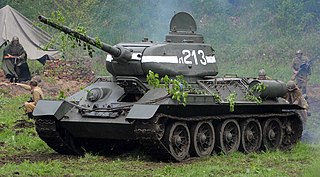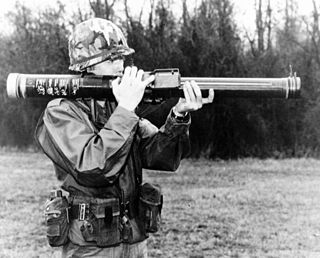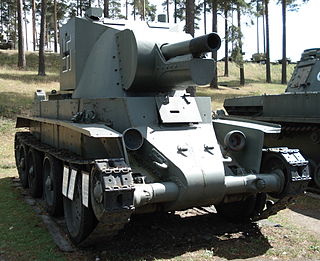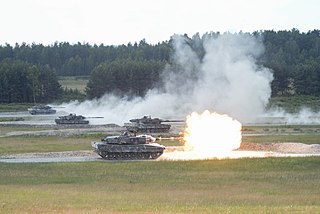
A tank is an armoured fighting vehicle intended as a primary offensive weapon in front-line ground combat. Tank designs are a balance of heavy firepower, strong armour, and battlefield mobility provided by tracks and a powerful engine; their main armament is often mounted within a turret. They are a mainstay of modern 20th and 21st century ground forces and a key part of combined arms combat.

The T-34 is a Soviet medium tank from World War II. When introduced, its 76.2 mm (3 in) tank gun was more powerful than its contemporaries, and its 60-degree sloped armour provided good protection against anti-tank weapons. The T-34 had a profound effect on the conflict on the Eastern Front, and had a long-lasting impact on tank design. The tank was praised by multiple German generals when encountered during Operation Barbarossa, although its armour and armament were surpassed later in the war. Its main strength was its cost and production time, meaning that German panzer forces would often fight against Soviet tank forces several times their size. The T-34 is also a critical part of the mechanized divisions that form the backbone of the Deep Battle Strategy.

The T-26 tank was a Soviet light tank used during many conflicts of the Interwar period and in World War II. It was a development of the British Vickers 6-Ton tank and was one of the most successful tank designs of the 1930s until its light armour became vulnerable to newer anti-tank guns. It was produced in greater numbers than any other tank of the period, with more than 11,000 units manufactured giving it the title of the most produced tank during the interwar period. During the 1930s, the USSR developed 53 variants of the T-26, including flame-throwing tanks, combat engineer vehicles, remotely controlled tanks, self-propelled guns, artillery tractors, and armoured carriers. Twenty-three of these were series-produced, others were experimental models.

The T-35 was a Soviet multi-turreted heavy tank of the interwar period and early Second World War that saw limited service with the Red Army. Often called a land battleship, it was the only five-turreted heavy tank in the world to reach production, but proved to be slow and mechanically unreliable. Most of the T-35 tanks still operational at the time of Operation Barbarossa were lost due to mechanical failure rather than enemy action. It was designed to complement the contemporary T-28 medium tank; however, very few were built.

The BT tank was one of a series of Soviet light tanks produced in large numbers between 1932 and 1941. They were lightly armoured, but reasonably well-armed for their time, and had the best mobility of all contemporary tanks. The BT tanks were known by the nickname Betka from the acronym, or by its diminutive Betushka. The successor of the BT tanks was the famous T-34 medium tank, introduced in 1940, which would replace all of the Soviet fast tanks, infantry tanks, and light tanks in service.

The BT-7 was the last of the BT series of Soviet cavalry tanks that were produced in large numbers between 1935 and 1940. It was lightly armoured, but reasonably well-armed for the time, and had much better mobility than other contemporary tank designs. The BT tanks were known by the nickname Betka from the acronym, or its diminutive, Betushka.

Radio control is the use of control signals transmitted by radio to remotely operate a device. Examples of simple radio control systems are garage door openers and keyless entry systems for vehicles, in which a small handheld radio transmitter unlocks or opens doors. Radio control is also used for control of model vehicles from a hand-held radio transmitter. Industrial, military, and scientific research organizations make use of radio-controlled vehicles as well. A rapidly growing application is control of unmanned aerial vehicles for both civilian and military uses, although these have more sophisticated control systems than traditional applications.

Anti-tank warfare originated during World War I from the desire to develop technology and tactics to destroy tanks. After the Allies deployed the first tanks in 1916, the German Empire introduced the first anti-tank weapons. The first developed anti-tank weapon was a scaled-up bolt-action rifle, the Mauser 1918 T-Gewehr, that fired a 13.2 mm cartridge with a solid bullet that could penetrate the thin armor used by tanks at that time and destroy the engine or ricochet inside, killing occupants. Because tanks represent an enemy's strong force projection on land, military strategists have incorporated anti-tank warfare into the doctrine of nearly every combat service since. The most predominant anti-tank weapons at the start of World War II in 1939 included the tank-mounted gun, anti-tank guns and anti-tank grenades used by the infantry, and ground-attack aircraft.

The BT-42 was a Finnish assault gun, constructed during the Continuation War. It was constructed from captured Soviet BT-7 light tanks and British 4.5-inch howitzers from 1918, which had been donated during the Winter War. Only eighteen vehicles were constructed, yet only 1 survives to this day, housed at the Parola Tank Museum.

A remote-control vehicle is defined as any vehicle that is teleoperated by a means that does not restrict its motion with an origin external to the device. This is often a radio-control device, a cable between the controller and the vehicle, or an infrared controller.

Armoured warfare or armored warfare, is the use of armoured fighting vehicles in modern warfare. It is a major component of modern methods of war. The premise of armoured warfare rests on the ability of troops to penetrate conventional defensive lines through use of manoeuvre by armoured units.

The T-38 amphibious scout tank was a Soviet amphibious light tank that saw service in World War II. Developed as a modernized version of the earlier T-37A light tank, the T-38 proved to be only a moderate improvement over its predecessor, and was eventually replaced in 1940 by the T-40.

The Type 95 Ha-Gō was a light tank used by the Empire of Japan during the Second Sino-Japanese War, at Nomonhan against the Soviet Union, and in the Second World War. It proved sufficient against infantry but was not effective against other tanks. Approximately 2,300 were produced, making it the most numerous Japanese armoured fighting vehicle of the Second World War.

Tanks were initially deployed in World War I, engineered to overcome the deadlock of trench warfare. Between the two world wars, tanks were further developed. Although they had demonstrated their battlefield effectiveness, only a few nations had the industrial resources to design and build them. During and after World War I, Britain and France pioneered tank technology, with their models generally serving as a blueprint for other countries. However, this initial advantage would slowly diminish during the 1930s, shifting in favor of the Soviet Union and, to a lesser degree, Nazi Germany.

Tanks were an important weapons system in World War II. Although tanks in the inter-war years were the subject of widespread research, few were made, in just a few countries. However, during World War II, most armies employed tanks, and thousands were built every month. Tank usage, doctrine, and production varied widely among the combatant nations. By war's end, a consensus was forming on tank doctrine and design.
A tank corps was a type of Soviet armoured formation used during World War II.

More than 50 different modifications and experimental vehicles based on the T-26 light infantry tank chassis were developed in the USSR in the 1930s, with 23 modifications going into series production. The majority were armoured combat vehicles: flame tanks, artillery tractors, radio-controlled tanks (teletanks), military engineering vehicles, self-propelled guns and armoured personnel carriers. They were developed at the Leningrad Factory of Experimental Mechanical Engineering by talented Soviet engineers P.N. Syachentov, S.A. Ginzburg, L.S. Troyanov, N.V. Tseits, B.A. Andryhevich, M.P. Zigel and others. Many Soviet tank engineers were declared "enemies of the nation" and repressed during Stalin's Great Purge from the middle of the 1930s. As a result, work on self-propelled guns and armoured carriers ceased in the USSR during that time. T-26 light tanks were also modified into armoured combat vehicles in the field during wartime.

Though nearly obsolete by the beginning of World War II, the T-26 was the most important tank of the Spanish Civil War and played a significant role during the Battle of Lake Khasan in 1938 as well as in the Winter War. The T-26 was the most numerous tank in the Red Army's armoured force during the German invasion of the Soviet Union in June 1941. The Soviet T-26 light tanks last saw combat in August 1945, in Manchuria.
This article deals with the history and development of tanks of the Soviet Union and its successor state, the Russian Federation; from their first use after World War I, into the interwar period, during World War II, the Cold War and modern era.
The 13th Light Tank Brigade was an armored brigade of the Red Army that fought in the Winter War. It was formed as the 31st Uritsky Mechanized Brigade in 1932 at Stary Petergof near Leningrad, assigned to the 11th Mechanized Corps, one of the first armored units of the Red Army. Two years later, the brigade became part of the new 7th Mechanized Corps, and it sent crews to fight in the Spanish Civil War. When the corps was redesignated as the 10th Tank Corps, the brigade became the 13th Light Tank Brigade in 1938. In late 1939, it and the corps participated in the massing of forces on the Estonian and Latvian borders to force their governments to agree to Soviet demands.

















